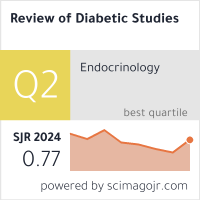Metabolic Syndrome As A Predictor Of Incident Type 2 Diabetes And Cardiovascular Events In The Kirkuk Population: A Prospective Cohort Study
DOI:
https://doi.org/10.1900/9k2hdt09Keywords:
Metabolic syndrome; type 2 diabetes mellitus; cardiovascular events; uric acid; risk prediction; cohort study; iraq.Abstract
Background: Metabolic Syndrome (MetS) is a significant public health concern, but its predictive power and the utility of including hyperuricemia in its definition are not fully characterized in all populations. This study aimed to assess MetS as a predictor for incident Type 2 Diabetes (T2DM) and Cardiovascular Events (CVEs) in an Iraqi cohort and to determine if adding serum uric acid (SUA) to the diagnostic criteria improves risk prediction.
Methods: This prospective cohort study was conducted at the Baba GurGur Diabetic Center in Kirkuk, Iraq. An initial cohort of 379 North Oil Company employees, including administrators, craftsmen, and their families, visiting Kiwan Hospital in northern Kirkuk. Three hundred seventy-nine participants were enrolled in 2015 and followed for 5 years, with 375 participants (98.9% retention) included in the final analysis. MetS was defined using the National Cholesterol Education Program Adult Treatment Panel III (NCEP ATP III) criteria.
AIM: The primary outcomes were incident T2DM and a composite of major non-fatal CVEs. Cox proportional hazards regression was used to calculate hazard ratios (HRs).
Results: The mean age of the cohort was 47.2 ± 9.8 years, and 59.7% were male. The baseline prevalence of standard MetS was 38.4%. Over 1,875 person-years of follow-up, 118 new cases of T2DM, and 32 incident CVEs occurred. The risk for both outcomes increased in a dose-response manner with the number of MetS components. After full adjustment, standard MetS was a significant predictor for both T2DM (HR: 3.95, 95% CI: 2.63–5.93) and CVEs (HR: 2.33, 95% CI: 1.15–4.71). A modified definition including hyperuricemia (MetS-UA) showed a stronger predictive association for both T2DM (HR: 4.31, 95% CI: 2.91–6.38) and CVEs (HR: 2.78, 95% CI: 1.41–5.48). Adding uric acid to the model significantly improved risk discrimination for both T2DM (ΔC-statistic: 0.024, p=0.025) and CVEs (ΔC-statistic: 0.029, p=0.042).
Conclusion: In this Iraqi cohort, MetS is a potent predictor of incident T2DM and CVEs, with risk escalating with the accumulation of metabolic abnormalities. The inclusion of Serum uric acid in the diagnostic criteria significantly enhances the predictive power of MetS for both cardiometabolic outcomes. These findings support aggressive screening for MetS and its components, including uric acid, for primordial prevention.
Downloads
Published
Issue
Section
License

This work is licensed under a Creative Commons Attribution-ShareAlike 4.0 International License.


